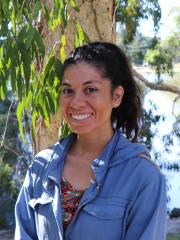
Ecophysiology and molecular genetics of selenium tolerance and accumulation in the selenium hyperaccumulator Neptunia amplexicaulis
Kathy is undertaking her PhD research on Neptunia amplexicaulis, a species native from Queensland known as a selenium hyperaccumulator. The mechanisms of selenium accumulation and tolerance are not known in detail and the genes involved in this response are also unknown. Therefore, Kathy is studying the molecular genetics and physiology of selenium tolerance and accumulation in this species. Her project involves the study of Neptunia genome as well as the gene profile expression in relation to selenium localisation in the different tissues compared to its relative, the non-accumulating Neptunia gracilis.
Kathy holds a bachelor's degree in Biotechnology from the Universidad Andres Bello, Chile, and a Master's degree in Plant Biotechnology from the same institution. She has worked in Plant Science for the last few years and is most passionate about it. The ability of plants to adapt to different environmental conditions never ceases to surprise her, especially under harsh conditions such as drought, salinity, lack of nutrients, and contaminated soil. Kathy is also passionate about gene expression profiles and genomics analyses ever since working on her thesis project, and she would like to continue the study of the mineral uptake/transport system, but with a focus on addressing environmental issues related to contaminants in soils.
